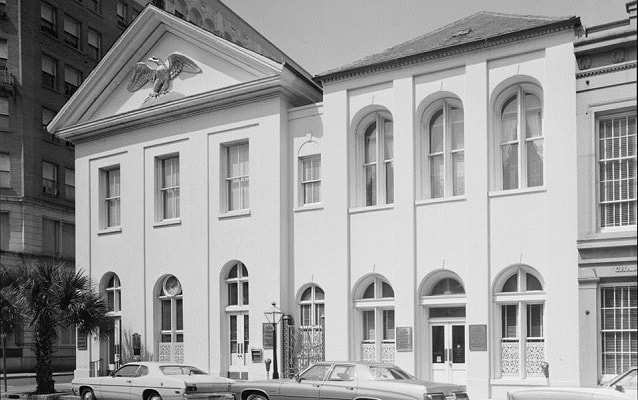Last updated: February 20, 2018
Place
South Carolina Bank of Charleston

Quick Facts
Location:
16 Broad Street, Charleston, SC
The South Carolina National Bank of Charleston is one of the most important buildings on Broad Street, South Carolina's oldest commercial street. It has been in continuous use as a bank since it was constructed in 1817. In the early 19th century, Charleston ranked highly enough as a commercial center to have a branch of the Second Bank of the United States, whose charter was drawn up by John C. Calhoun, the State's preeminent statesman. This financial institution was the second attempt at a national bank; The First Bank of the United States had also established a branch in Charleston, now City Hall. This Second Bank branch, that of Discount and Deposit, was the only bank in the city equipped to handle the international transactions so crucial to the rice trade, a mainstay of the Lowcountry economy. Stucco covers the masonry walls of the two story building. The smooth, clean exterior is accentuated by simple arched and rectangular window and door openings. A gold leaf eagle still adorns the gable of the front of the bank, as it has since 1817. The lobby, also in continuous use since the bank's opening, features more elaborately carved details, and has been altered only with the addition of lights and modern teller windows.
The newly chartered Bank of Charleston purchased the building in 1836, shortly after the Second Bank failed following the withdrawl of all government deposits by President Andrew Jackson. By 1848 the Bank of Charleston became a regional power with affiliates in Georgia, Alabama, Florida, and Louisiana. The building was extended to the north in 1856 and the Board of Director's Room added. It is an elaborate room with coved ceiling, pilasters with Corinthian capitals, and marbelized details (wood painted to simulate tan and black marble). The bank managed to survive financially during the Civil War and Reconstruction, despite a $1.5 million loan to the Confederacy, and by 1887 had recovered sufficiently to become a Federal Depository. In 1926 the Bank of Charleston merged with local banks in Greenville and Columbia to form the South Carolina National Bank, which in turn was absorbed by Wachovia in the mid-1990s.
The newly chartered Bank of Charleston purchased the building in 1836, shortly after the Second Bank failed following the withdrawl of all government deposits by President Andrew Jackson. By 1848 the Bank of Charleston became a regional power with affiliates in Georgia, Alabama, Florida, and Louisiana. The building was extended to the north in 1856 and the Board of Director's Room added. It is an elaborate room with coved ceiling, pilasters with Corinthian capitals, and marbelized details (wood painted to simulate tan and black marble). The bank managed to survive financially during the Civil War and Reconstruction, despite a $1.5 million loan to the Confederacy, and by 1887 had recovered sufficiently to become a Federal Depository. In 1926 the Bank of Charleston merged with local banks in Greenville and Columbia to form the South Carolina National Bank, which in turn was absorbed by Wachovia in the mid-1990s.
